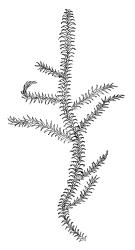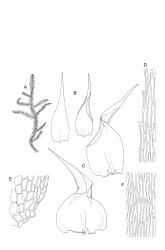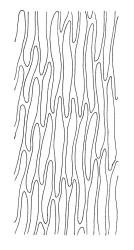- ≡ Hypnum squarrosum Hedw., Sp. Musc. Frond. 281 (1801)
Plants fairly robust, yellow- or bright-green, shiny, forming extensive wefts. Stems commonly 50–80(–150) mm, orange, mostly obscured by the sheathing leaves, irregularly branched, ascendant; branches tapered and acute, decurved. Stem and branch leaves differentiated. Stem leaves sheathing, strongly squarrose, broadly ovate-lanceolate, concave and smooth below both moist and dry, gradually tapered to a channelled acumen, scarcely cordate at base, serrulate to base or nearly so, c. 2.8–3.5 × 1.1–1.5 mm; mid laminal cells elliptic-linear, prorate (upper cell ends weakly projecting on abaxial surface), scarcely porose, mostly 45–66 × 6–7 µm, becoming longer and more or less porose towards leaf base; alar cells slightly inflated, not or weakly porose, forming a large but rather poorly delimited elliptic group. Branch leaves narrower and more lanceolate. Costae c. ¼ the leaf length. Pseudoparaphyllia not seen.
Perichaetia scattered on main stems, the inner leaves narrowly acuminate and squarrose. Perigonia and sporophytes not seen.
Brotherus 1925, fig. 762; Crum & Anderson 1981, fig. 602; Smith 2004, fig. 312.
Rhytidiadelphus squarrosus is likely to be confused only with Ptychomnion densifolium, but can be differentiated from that species by its non-twisted leaf apices, the presence of a large but weakly delimited elliptic group of slightly inflated alar cells, and the near or total absence of pores in its mid laminal cell walls. Additionally R. squarrosus is a less compact and more branched species occurring in lowland disturbed habitats, in contrast to the mostly high elevation P. densifolium. Confusion with the widespread and mostly subaquatic Cratoneuropsis relaxa seems less likely; some distinguishing features are discussed under that species.
SI: Nelson, Canterbury (near Arthur’s Pass Village), Westland, Otago (Makarora, Dunedin area, Catlins River), Southland (Milford Sound.); St; Ch (Pitt I.).
Adventive. Tasmania*. Widespread in the northern hemisphere.
Restricted to disturbed and roughly-mown areas such as road verges, picnic sites, campgrounds, and golf courses. It is a very common species on the west coast of the South I. from at least the Denniston area south to Milford Sound and is known in the Dunedin area. P.J. Dalton and C. Brooker (pers. comm., 29 Jan. 2007) made an unsuccessful effort to locate additional sites in southern Otago and eastern Southland L.D. in Jan. 2007. However, J. Beever (pers. comm., 30 April 2014) collected it at the Catlins River (in southern Otago) in Jan. 2014. It often occurs abundantly in disturbed, moist, and strongly insolated sites and its spread is almost certainly encouraged by mowing. The apparent absence of this species from wetter parts of the North I. is curious and its eventual collection there is to be expected. Ranging from near sea level to c. 580 m (at Denniston Plateau, Nelson L.D.). Frequent associates include Eurhynchium praelongum, Thuidium furfurosum, and Calliergonella cuspidata.
The initial report of R. squarrosus in N.Z. was made by Child & Allison (1975) from a clayey slope in a golf course fairway where it occupied an area c. 50 m in diameter.
I have seen no male plants or sporophytes in N.Z. material; however P. Dalton (pers. comm., 12 Sept. 2007) informs me that male plants occur in the Haast (Westland L.D.) area. He has also seen male plants from Tasmania. This suggests that at least two introductions may have been made of this species on South I. A large fraction of collections are from road verges. The species appears to be actively expanding its range in the South I. at the time of writing.










